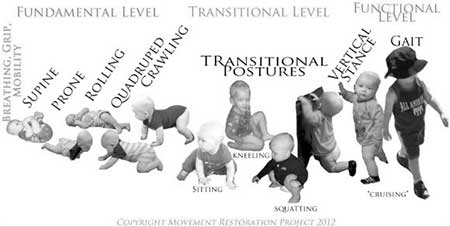3letterslong
Level 6 Valued Member
Where I bolded and starred, I'm assuming you mean "crawls?"
Not trying to be nit-picky, just trying to clarify.
One of the great things about crawling is actually how versatile you can be with it. It only "doesn't provide spinal mobility qualities" if you keep your torso stiff. You can add a degree of lateral spinal flexion to it as you move forwards or backwards, and this actually mimics what should happen in the gait cycle. In crawling, the spine will flex towards the side of the arm that is planted as the other reaches forward. It also undergoes a degree of rotation during the gait cycle. A more global degree of mobility can be worked by advancing the degree of motion the body undergoes while crawling.
Since OS is popular around here, other, more advanced crawling variations don't get as much attention. A word about them, though: they are somewhat analogous to different size bells in the TGU. Baby and leopard crawls are very easy to do a high volume of, and are quite accessible, so the most people will be using them. If you are looking for your crawling to translate to pressing, for example, they may help, as the torso stays mostly "straight," mimicking what the shoulders and "core" do in a press. However, there are other variations that may also assist the press (see below).
Baby crawling is the easiest, most accessible form of crawling. If need be, it can be regressed to rocking variations. Then you'd do leopard, then "spider man," THEN I would work in incline/decline crawling and crawling with pushups integrated. At the high end of crawling difficulty, I would place low lizard crawls and incline/decline lizard crawls.
So a rough "progression" could be:
-Baby crawls
-Leopard Crawls
-Spiderman crawls, loaded crawling, straight arm lizard crawls
-Incline/decline crawls, crawls w/pushups
-low lizard crawls
-incline/decline crawls
So all this is just to say that if one gets proficient at leopard crawling, they can probably introduce more complexity to it to reap further, wider ranging rewards. They don't have to though. They can load crawls instead, if it suits them better.
Referencing the video below:
Just to repeat it, since this kind of stuff (imo) unfairly gets bashed.... this is NOT where one starts!!!! This is after all the other stuff. If the baby crawl is a 12-16kg bell in the TGU, then incline/decline lizard crawls are like using the beast for TGU.
What I find interesting is that we know that training a muscle at longer lengths can increase strength throughout the full ROM. So what happens if you are also teaching the muscles to coordinate and manage your center of mass under load, at longer lengths? Check out the depth experienced in the shoulder girdle! Also, here's your comination of dynamic core stability (stability NOT meaning "stiffness"), pressing strength, spinal and hip mobility .... all in one move.
Link to video of lizard crawls on stairs:

Stairs can be a great tool for movement development with their jagged edges, incremental ascent/descent and dealing with incline and decline. I use many... | By Ido Portal | Facebook
Stairs can be a great tool for movement development with their jagged edges, incremental ascent/descent and dealing with incline and decline. I use many...fb.watch
lol thank you for making me coherent! Yes, those were supposed to be "crawls".
That's really interesting regarding lateral motions in the crawl. I've been treating them like bird dogs and not allowing myself any sway whatsoever. I'm going to have to try swaying and see what it feels like.
That crawl progression is perfect! I searched for a long time looking for a good progression and that beats everything I found.
That video is bananas. Dear god.

